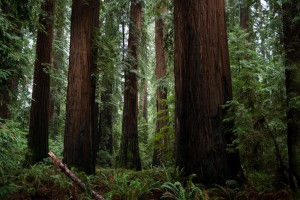
By Crista Ray
My name is Crista Ray and I am a Sinkyone descendant. I am a member of the Scotts Valley Band of Pomo Indians and represent my Tribe on the board of the InterTribal Sinkyone Wilderness Council (Sinkyone Council). The Sinkyone Council is a Tribal non-profit consortium comprised of ten federally recognized Northern California Indian Tribes with cultural connections to the lands and waters of traditional Sinkyone and neighboring Tribal territories. Richardson Grove comprises an important area of Sinkyone traditional territory, and is a Sinkyone cultural heritage area of immense significance to Tribes and Tribal Peoples of the region.
Today, Richardson Grove continues to hold great cultural significance as an important place of prayer, ceremony and cultural lifeways. This is in part because Richardson Grove is one of only a few remaining ancient redwood groves, a critical part of the surviving 2% old-growth redwood still standing. Gááhs-tcho (coast redwood tree in Sinkyone language, also referred to as Na-Gááh-tcho) is a special relative whom Indigenous Peoples are taught to never harm. Tribal leaders throughout the redwood region often have spoken of the duty to honor and protect the Gááhs-tcho, and warned about the consequences of harming them. The Sinkyone, along with many other Indigenous Peoples, relate to Gááhs-tcho as communities of sacred beings who provide protection, abundance and balance for the world. If the Grove is harmed, then so are the Sinkyone People and this world.
That is why we are opposed to Caltrans’ so-called “Richardson Grove Improvement Project”. While Caltrans insists that no old-growth Gááhs-tcho would be removed if the project were implemented, the project’s plans require severing significant numbers of large old-growth tree roots, paving them over with concrete, and removing many neighboring trees. This is unacceptable and would permanently harm these trees and Tribal cultural heritage.
Anyone who has ever walked through an old-growth Gááhs-tcho grove knows the grandeur of these incredible beings. But, something you don’t get to fully appreciate when walking above ground is their incredible root systems. Unlike many other trees, Gááhs-tcho roots are relatively shallow, usually only about 6-12 feet deep. How does the tallest tree on earth stay upright with such shallow roots?
Instead of burrowing down, Gááhs-tcho roots spread out over a large area. As they do, they intertwine with their neighbors and form an interlocking root system that holds up the individual trees. This strategy is what prevents Gááhs-tcho from falling over during the many strong windstorms and earthquakes they experience over their incredibly long lives. So, cutting a significant number of large old-growth Gááhs-tcho roots, particularly old-growth Gááhs-tcho whose root system have developed over centuries or even millennia, will endanger the entire Grove by weakening its support structure. Even if the Grove survives the immediate effects of the cuttings, Caltrans will have forever weakened the resiliency of the Grove.
There is another reason why cutting significant numbers of Gááhs-tcho roots is a threat to the health of the entire Grove. Western science has recently duplicated what Indigenous Peoples have known since time immemorial, that every tree in a forest is linked, even trees of different species. A complex symbiotic relationship between the root systems of trees and fungi, known to scientists as a mycorrhizal network, allows trees to share a vast store of knowledge and understanding—as well as support, love and nutrients—with one another. Scientists have documented trees sharing carbon, water, nitrogen and other nutrients via this underground network. Researchers have even documented chemical alarm signals being shared from tree to tree that warn of drought or beetle infestation.
Trees are not inanimate objects, indifferent to the world around them. They are part of a community that depends upon its members in order to survive and thrive. For decades, foresters who traditionally viewed every tree as an individual have dismissed or rejected this research because of its implications. As such, researchers are still learning much about how mycorrhizal networks operate in Gááhs-tcho forests. Given the scientific community’s lack of understanding on this issue and the sacred and irreplaceable nature of old-growth Gááhs-tcho, Caltrans has a duty not to damage their root systems.
Written by Crista Ray and shared with her permission .


Comments